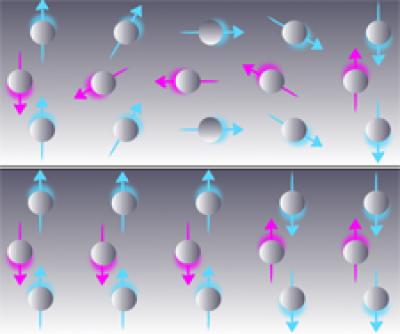Multiferroics are materials that can be polarized both electrically and magnetically.
 In TbFeO3 researchers discovered an unusual spin order for the magnetic field where the change in spin direction along a line of atoms occurs suddenly. There is a formation of what is known as a soliton domain wall. The size of the spin-up (or down) domains is approx. 20 nanometer, while the domain walls are a few tenths of nanometer, which is a very unusual combination. In the lower figure one of these domain walls is illustrated, whose sharpness is caused by the large amount of congruent diffraction data for the so-called candlestick figure. The upper figure shows how these domain walls can appear in more traditional materials, where the wall is thicker and the spin rotates slowly from up-mode to down-mode from left to right. (Credit: Niels Bohr Institute)
In TbFeO3 researchers discovered an unusual spin order for the magnetic field where the change in spin direction along a line of atoms occurs suddenly. There is a formation of what is known as a soliton domain wall. The size of the spin-up (or down) domains is approx. 20 nanometer, while the domain walls are a few tenths of nanometer, which is a very unusual combination. In the lower figure one of these domain walls is illustrated, whose sharpness is caused by the large amount of congruent diffraction data for the so-called candlestick figure. The upper figure shows how these domain walls can appear in more traditional materials, where the wall is thicker and the spin rotates slowly from up-mode to down-mode from left to right. (Credit: Niels Bohr Institute)
This material was discovered in the 1960s by Russian researchers. In the past, there have been very few attempts to study these materials as the required technology did not exist. Current technology facilitates the study of these materials right down to the atomic level. Researchers at Copenhagen University’s Niels Bohr Institute have examined such a material and the results of the study published in the scientific journal, Nature Materials, could lead to technological advancements, particularly in sensors.
The experiments were carried out in Berlin at the Helmholtz-Zentrum neutron research facility in collaboration with researchers from ESS in Lund, Risø, Holland and Germany. The team examined the iron compound TbFeO3, which is a naturally occurring rare material, using potent neutron radiation under a magnetic field at near absolute zero temperature level of minus 271oC. The material was found to be made of a well-defined lattice structure comprising rows of terbium atoms separated by atoms of oxygen and iron. Though such congruent lattice structures are familiar to researchers, the magnetic domains witnessed here are something new. Usually, magnetic domains are oriented haphazardly. But the researchers found them to be oriented straight and equidistant from one another. Calculations have aided the team to determine the relationship between the material structure and its physical characteristics. The models demonstrate a Yukawa-like force caused by the interaction of the terbium walls through the magnetic iron lattice by means of spin exchange. The waves of spin magnetism increase the electric polarization and the resulting interaction between terbium ions generates a powerful magneto-electric effect. The insight gained could aid in the discovery and creation of new multiferroics.